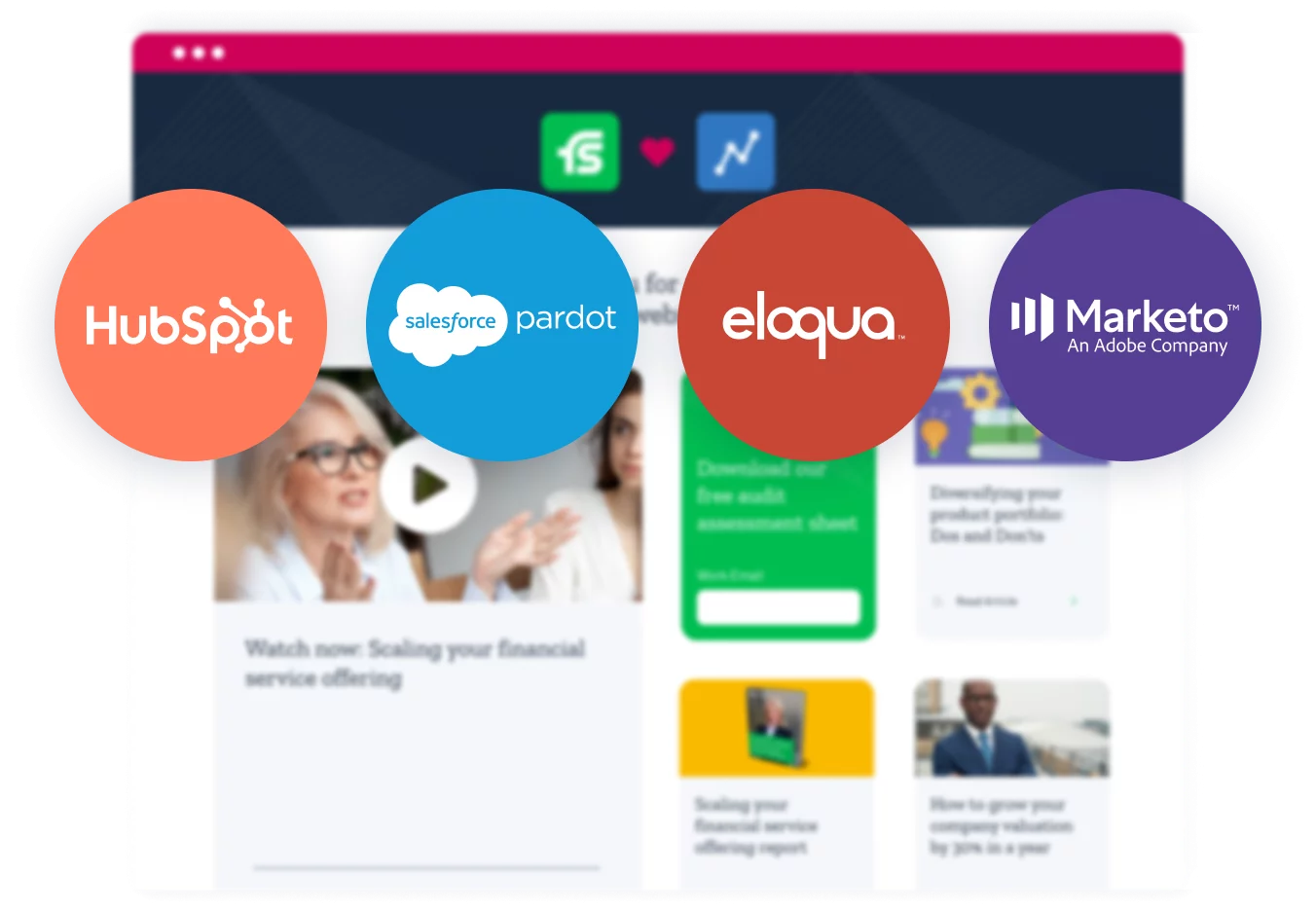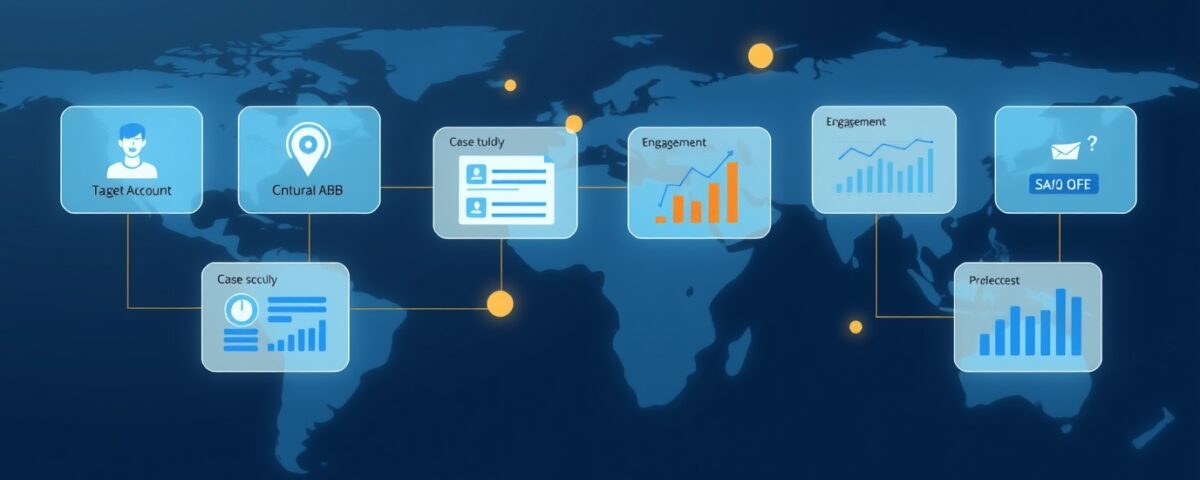
Driving Business Growth Through AI Marketing in Singapore
September 11, 2025
Singapore’s Leading AI Marketing Agency: Drive Growth with AI
September 12, 2025Account-Based Marketing (ABM) has gained significant popularity among B2B marketers for its ability to drive personalized engagement and deliver results. While the concept of ABM is widely understood, learning from real-life examples can provide valuable insights and inspiration for creating successful campaigns. In this blog post, we will explore real-life examples of account-based marketing campaigns and extract key lessons that can help guide your own ABM initiatives.

- IBM’s “Watson at Work” Campaign:
IBM’s Watson at Work campaign is a standout example of successful ABM. The company targeted specific key accounts in the healthcare industry and used personalized content to engage decision-makers. They created tailored videos, blog posts, and case studies showcasing how Watson’s cognitive capabilities could transform healthcare operations. By demonstrating a deep understanding of their target accounts’ pain points and offering personalized solutions, IBM achieved impressive results and secured new business.
Lesson: Personalization is paramount in ABM. Tailor your messaging and content to address the specific needs and challenges of each target account.
By leveraging personalized content and engaging key decision-makers, IBM aimed to position Watson as a transformative solution for healthcare operations.
Key Elements and Strategies:
1. Deep Understanding of Target Accounts:
IBM invested time and effort into understanding the unique challenges and pain points of their target accounts in the Singapore healthcare sector. By gaining a comprehensive understanding of the industry landscape and the specific needs of their audience, IBM could tailor their messaging and solutions accordingly.
2. Personalized Content Creation:
To engage their target accounts effectively, IBM created a range of personalized content assets. These included customized videos, blog posts, and case studies that highlighted how Watson’s cognitive capabilities could address the specific challenges faced by healthcare organizations in Singapore. By demonstrating a clear understanding of their audience’s pain points and offering tailored solutions, IBM captured the attention and interest of key decision-makers.
3. Targeted Distribution Channels:
IBM carefully selected the appropriate distribution channels to reach their target accounts in the Singapore healthcare industry. They utilized a mix of digital platforms, industry events, and partnerships to maximize visibility and engagement. By strategically targeting their distribution efforts, IBM ensured that their content reached the right audience at the right time.
4. Thought Leadership Positioning:
IBM positioned themselves as thought leaders in the healthcare industry through their “Watson at Work” campaign. By sharing valuable insights, industry trends, and success stories, they established credibility and trust among their target accounts in Singapore. This thought leadership positioning fostered stronger relationships and positioned IBM as the go-to provider for cognitive technology solutions.
Lessons from IBM’s “Watson at Work” Campaign:
-
In-depth Research and Understanding: Take the time to thoroughly research and understand the needs, pain points, and industry landscape of your target accounts in Singapore. This knowledge will enable you to tailor your messaging and solutions effectively.
-
Personalization is Key: Create personalized content that resonates with your target accounts. Address their specific challenges and demonstrate how your solutions can solve their problems. Personalization increases engagement and enhances the likelihood of conversion.
-
Choose the Right Channels: Select the most relevant distribution channels to reach your target accounts in Singapore. Consider digital platforms, industry events, and partnerships that will maximize visibility and engagement within your specific industry.
-
Establish Thought Leadership: Position yourself as a thought leader in your industry by sharing valuable insights, trends, and success stories. This positions your brand as a trusted advisor and builds credibility among your target accounts.
![NEW_FMF_Logo_Lockup[2]](https://www.ismartcom.com/hubfs/NEW_FMF_Logo_Lockup%5B2%5D.jpg)
- Terminus’ “Flip My Funnel” Campaign:
Terminus, a leading ABM platform, launched the “Flip My Funnel” campaign to challenge traditional marketing and sales funnels. They hosted events, webinars, and created an online community to engage their target audience. Through their campaign, Terminus positioned themselves as thought leaders and advocates for ABM, fostering a sense of community and driving industry-wide conversations.
Lesson: Building a community and thought leadership can generate long-term engagement and establish your brand as a trusted advisor.
By hosting events, webinars, and creating an online community, Terminus successfully positioned themselves as thought leaders and advocates for ABM in Singapore.
Key Elements and Strategies:
1. Challenging the Funnel Paradigm:
Terminus’ “Flip My Funnel” campaign centered around challenging the traditional marketing and sales funnel. By questioning the traditional approach and offering an alternative perspective, Terminus sparked curiosity and engaged the target audience in Singapore.
2. Thought Leadership and Community Building:
Terminus established themselves as thought leaders by organizing events, webinars, and creating an online community focused on ABM. Through these initiatives, they provided educational content, industry insights, and a platform for networking and knowledge-sharing. This approach helped build a community of ABM enthusiasts in Singapore and positioned Terminus as a go-to resource for ABM expertise.
3. Industry Collaboration and Partnerships:
Terminus collaborated with industry experts, influencers, and organizations in Singapore to amplify their campaign’s reach and impact. By partnering with local industry leaders, they gained credibility and expanded their network, enhancing the campaign’s effectiveness.
4. Multichannel Engagement:
To maximize engagement, Terminus implemented a multichannel approach. They utilized digital channels, social media platforms, email marketing, and offline events to create touchpoints with their target audience in Singapore. By diversifying their communication channels, Terminus ensured they reached their prospects through their preferred mediums.
Lessons from Terminus’ “Flip My Funnel” Campaign:
-
Challenge the Status Quo: Don’t be afraid to question traditional approaches and offer new perspectives to captivate your target audience in Singapore. Presenting a fresh angle can help differentiate your brand and create curiosity.
-
Establish Thought Leadership: Position yourself as a thought leader by providing educational content, organizing events, and fostering an online community. Becoming a trusted resource builds credibility and strengthens relationships with your target accounts.
-
Leverage Industry Collaborations: Partner with industry experts, influencers, and organizations in Singapore to expand your reach and gain credibility within the local market. Collaborations can enhance your campaign’s impact and foster valuable relationships.
-
Embrace Multichannel Engagement: Implement a diverse range of communication channels to engage your target audience in Singapore. Utilize digital platforms, social media, email marketing, and offline events to create touchpoints and nurture relationships.

- Adobe’s “CIO.com” Campaign:
Adobe implemented a highly targeted ABM campaign to engage CIOs and IT decision-makers. They partnered with CIO.com, a popular publication, to create a dedicated microsite featuring exclusive content for their target accounts. By leveraging the credibility of the publication, Adobe increased visibility and engagement with their key audience, resulting in improved conversions and customer acquisition.
Lesson: Collaborating with trusted industry publications or influencers can amplify your reach and credibility within your target accounts.
By creating a dedicated microsite featuring exclusive content, Adobe aimed to position themselves as trusted advisors and solution providers to their target accounts.
Key Elements and Strategies:
1. Strategic Collaboration with CIO.com:
Adobe strategically partnered with CIO.com, a renowned publication catering to CIOs and IT professionals. This collaboration allowed Adobe to tap into the publication’s credibility, reach, and established audience base. By aligning with a trusted industry resource, Adobe enhanced their campaign’s visibility and positioned themselves as a valuable resource within the Singapore CIO community.
2. Personalized and Exclusive Content:
To engage their target audience effectively, Adobe created personalized and exclusive content for the CIO.com microsite. This content included thought leadership articles, industry insights, case studies, and practical guides tailored to the specific challenges faced by CIOs in Singapore. By providing valuable and exclusive content, Adobe demonstrated their understanding of the target accounts’ pain points and positioned themselves as a solution provider.
3. Thought Leadership and Expertise:
Adobe showcased their expertise and thought leadership by sharing valuable insights and best practices related to technology trends, digital transformation, and IT strategies. This approach not only positioned Adobe as a trusted advisor but also fostered deeper connections with the target accounts in Singapore.
4. Multi-channel Promotion:
To maximize visibility and engagement, Adobe employed a multi-channel promotional strategy. They utilized email marketing, social media, digital advertising, and direct outreach to ensure that their target accounts in Singapore were exposed to the campaign. This multi-channel approach allowed for broader reach and increased the chances of capturing the attention of their desired audience.
Lessons from Adobe’s “CIO.com” Campaign:
-
Strategic Partnerships: Collaborate with trusted industry publications or resources to leverage their credibility and reach. This partnership can significantly enhance your campaign’s visibility and impact.
-
Personalized and Exclusive Content: Develop content that is tailored to the specific needs and challenges of your target accounts. Providing exclusive and valuable insights positions your brand as a trusted resource and increases engagement.
-
Establish Thought Leadership: Share industry insights, thought leadership articles, and practical guides to position your brand as a knowledgeable and reliable advisor. This establishes credibility and fosters stronger relationships with your target audience.
-
Embrace Multi-channel Promotion: Utilize a mix of channels, such as email marketing, social media, digital advertising, and direct outreach, to ensure maximum exposure and engagement. Diversifying your communication channels increases the chances of reaching your target accounts effectively.

- Uberflip’s “Content Experience” Campaign:
Uberflip, a content experience platform, implemented an ABM campaign that focused on providing personalized content experiences for their target accounts. They created customized landing pages, interactive content hubs, and curated content playlists for each account. By delivering relevant and engaging content experiences, Uberflip significantly increased engagement, conversions, and pipeline velocity.
Lesson: Create personalized content experiences that cater to the specific interests and needs of each target account. Make it easy for them to access and consume relevant content.
By leveraging content as a strategic asset, Uberflip aimed to establish themselves as trusted partners in the target accounts’ buyer journeys.
Key Elements and Strategies:
1. Deep Account Understanding:
Uberflip invested time and effort into understanding the needs, pain points, and goals of their target accounts in Singapore. This deep account understanding enabled them to create highly relevant and personalized content experiences that resonated with their audience. By aligning their content with the specific challenges faced by their target accounts, Uberflip was able to drive engagement and build meaningful connections.
2. Personalized Content Journeys:
Uberflip crafted personalized content journeys for each target account, ensuring that the content delivered was relevant and valuable at every stage of the buyer’s journey. By tailoring the content to address the unique needs and interests of each account, Uberflip increased the effectiveness of their ABM campaign and fostered deeper engagement.
3. Interactive and Engaging Content Formats:
To capture and retain their target accounts’ attention, Uberflip utilized interactive and engaging content formats. They leveraged videos, interactive eBooks, quizzes, and personalized landing pages to create immersive content experiences. These formats not only provided valuable information but also encouraged active participation and increased the overall engagement levels.
4. Account-Specific Metrics and Analytics:
Uberflip closely monitored and analyzed account-specific metrics to measure the impact and success of their ABM campaign. By tracking engagement levels, content consumption, and conversion rates for each target account, Uberflip gained valuable insights that informed their ongoing marketing strategies and helped optimize their approach.
Lessons from Uberflip’s “Content Experience” Campaign:
-
Account-Centric Approach: Invest in understanding the unique needs, pain points, and goals of your target accounts in Singapore. Tailor your content experiences to address their specific challenges and provide value throughout their buyer’s journey.
-
Personalization is Key: Craft personalized content journeys that deliver relevant and valuable content at each touchpoint. Personalization enhances engagement and fosters stronger connections with your target accounts.
-
Interactive and Engaging Formats: Utilize interactive and engaging content formats to capture and retain your target accounts’ attention. Videos, quizzes, and personalized landing pages create immersive experiences that drive higher engagement levels.
-
Track Account-Specific Metrics: Monitor and analyze account-specific metrics and analytics to measure the effectiveness of your ABM campaign. These insights will help you optimize your strategies and drive better results.

- Demandbase’s “ABM Leadership Alliance” Campaign:
Demandbase, a pioneer in ABM, launched the ABM Leadership Alliance—a community-driven initiative aimed at educating and empowering marketers about ABM best practices. They brought together industry experts, hosted webinars, and created a platform for knowledge sharing and networking. Through this campaign, Demandbase positioned themselves as leaders in the ABM space while nurturing relationships with their target audience.
Lesson: Thought leadership initiatives and knowledge-sharing platforms can establish your brand as an industry authority and nurture relationships with key accounts.
Conclusion:
These real-life examples of successful account-based marketing campaigns provide valuable insights and lessons for crafting your own ABM initiatives. Remember the importance of personalization, community-building, thought leadership, collaboration, and creating tailored content experiences. By understanding the strategies and tactics that have worked for others, you can design effective ABM campaigns that drive engagement, nurture relationships, and deliver measurable results in your target accounts.
Check this out: https://www.ismartcom.com/account-based-marketing-abm-singapore-asia


